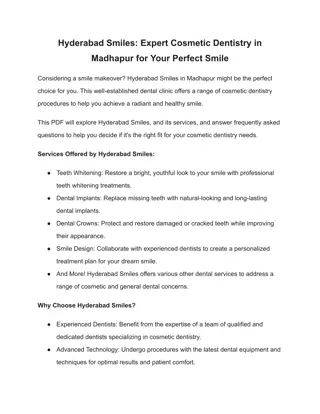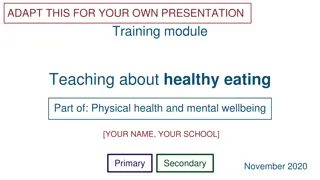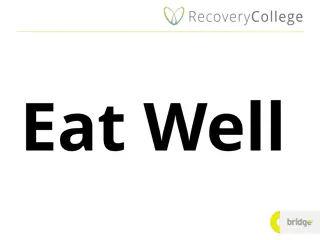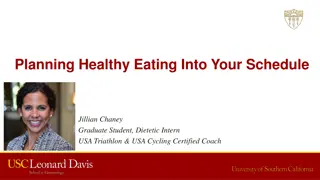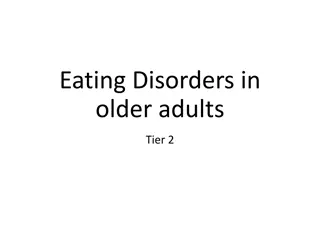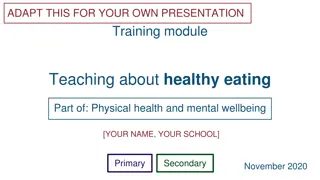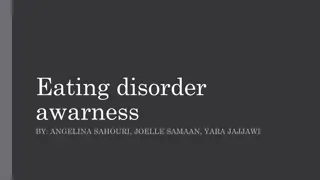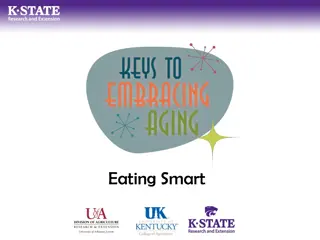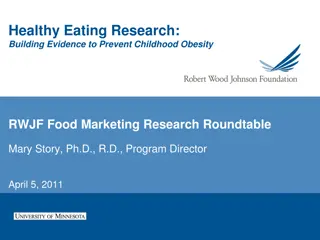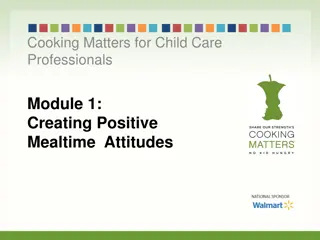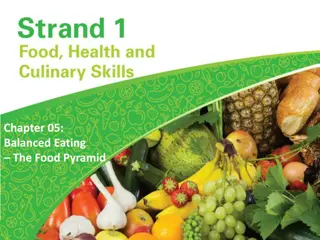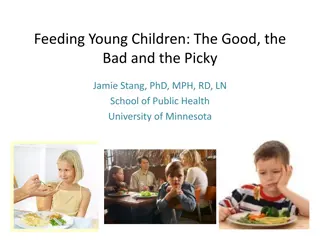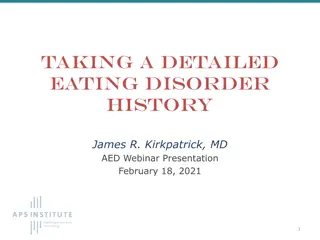Promoting Healthy Eating with the SMILE Project
The SMILE project is a school initiative aimed at promoting healthy eating habits among KS1 children by encouraging them to make healthier food choices and understand age-appropriate portion sizes. By replacing traditional meal trays with SMILE trays and providing education on nutrition, the project helps prevent chronic health disorders and influences positive food choices in children. Feedback from students, parents, and school staff indicates a successful implementation and support for the project's principles.
Download Presentation

Please find below an Image/Link to download the presentation.
The content on the website is provided AS IS for your information and personal use only. It may not be sold, licensed, or shared on other websites without obtaining consent from the author.If you encounter any issues during the download, it is possible that the publisher has removed the file from their server.
You are allowed to download the files provided on this website for personal or commercial use, subject to the condition that they are used lawfully. All files are the property of their respective owners.
The content on the website is provided AS IS for your information and personal use only. It may not be sold, licensed, or shared on other websites without obtaining consent from the author.
E N D
Presentation Transcript
What is the SMILE project? What is the SMILE project? The SMILE project is a school initiative to help KS1 children learn about healthy eating and encourage children to make healthier food choices. Also, it supports schools, parents & children to have a better understanding of age-appropriate portion sizes. The project involves delivering a healthy eating discussion and replacing the traditional school meal trays with SMILE trays (see the image on the left). 2
Eating behaviour and habits are formed from a young Eating behaviour and habits are formed from a young age age and therefore, establishing healthy eating habits in young children may prevent various chronic health disorders in childhood and adult life, including obesity, diabetes, hypertension, cardiovascular disease, cancer, and dental caries . Research has found that children s choice architecture architecture can be swayed by what is most visible and accessible. Therefore, small tweaks in the school environment and lunchtime offering can provide a nudging effect that leads to positive changes on their food choices . choice Similarly, research has also found that improving nutrition knowledge among school nutrition knowledge among school- -aged children associated with the adoption of healthier food choices . that improving aged children is 3
I like it, its colourful Student from Underhill Y1 I prefer it to the old one Student from Underhill R It helps me eat my vegetables Student from Annunciation Y2 The tray helps with serving The tray helps with serving meals. We meals. We no longer offer no longer offer the sweet pudding on a the sweet pudding on a Friday because when we do Friday because when we do offer it, most of the offer it, most of the children still choose the children still choose the freshly prepared fruit salad freshly prepared fruit salad that is offered daily. that is offered daily. I like that it looks nice Student from Annunciation R It was observed that almost all of the infant children in both schools chose fruit salad and also took salad from the salad bar Yinka Thomas, Nutritionist Debbie from Underhill Debbie from Underhill Primary School Primary School 4
Garden Suburb Infant School Garden Suburb Infant School The SMILE project was enjoyed by children and parents were positive about the intervention. The staff at the school reported that they felt the project helped the children to learn about healthy eating and encourage children to make healthier food choices. Overall, I would recommend this project. I really liked the principles of the project, and it really encouraged the children to fill the different food group sections of their tray. Miss Sands, Headteacher Miss Sands, Headteacher 5
Baseline phase Intervention phase Post-evaluation phase Promotion of parent portion size guidance booklet Baseline Lunchtime Assessment Post- evaluation lunchtime assessment Inform parents re SMILE project Healthy Eating Discussion Evaluation meeting Follow-up lunchtime assessment ( at 3 months) Inform pupils about SMILE project Replacement of old trays with the SMILE trays Code Blue- Evaluation Green- Introducing project to beneficiaries Red- Educating Purple-SMILE trays (nudge effect) ACTIVITY FLOWCHART ACTIVITY FLOWCHART 6
Table 1: Project task leads Teaching Teaching staff staff Admin staff Catering staff Catering staff Evaluation Evaluation Informing parents & Informing parents & children children Table 1 (on the right) summarizes the delegation of tasks between school staffing teams. It highlights the minimal level of teaching staff input required for the success of this project which is understandably a cause for concern for many schools. Promotion of the Promotion of the portion size booklet portion size booklet to parents to parents Healthy Eating Healthy Eating Discussion Discussion SMILE tray roll SMILE tray roll- -out out * A member of the children & young People s Barnet Public Health Team will be there to oversee and provide support to ensure the success of the project. 7
The following resources will be The following resources will be provided: provided: A parent letter draft to send out to parents informing them about the project A 30-minute healthy eating session lesson plan An activity log SMILE trays* A parent portion size booklet produced by Caroline Walker Trust will be available to download on the Barnet council website. * Please note that the SMILE trays are lighter than the traditional school meal trays. 8
How is effectiveness measured? How is effectiveness measured? Baseline lunchtime assessment Intervention duration (healthy eating session and SMILE tray roll out)-1 month Post lunchtime assessment Follow-up lunchtime assessment (at 3- months) The lunchtime assessment The lunchtime assessment This will involve looking to see if a higher proportion of children choose healthier food options at lunchtime than at baseline. 9






